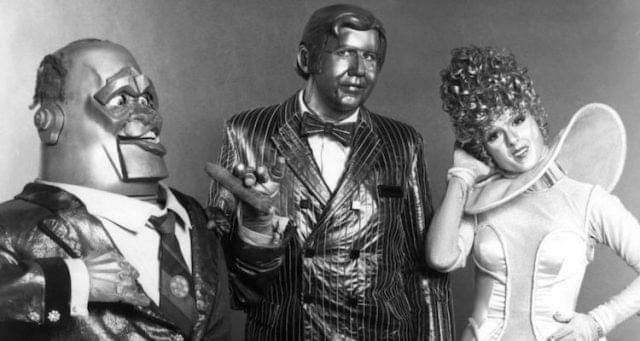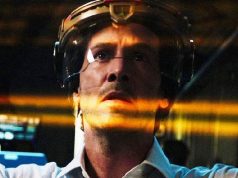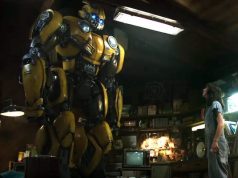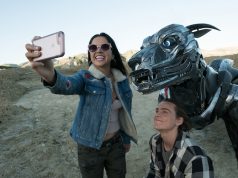
Today Andy Kaufman is best remembered as a stand-up comedian who specialized in finding ways to annoy or confuse his audience rather than amuse them. Evidently this was a lucrative career path. But the way most of America knew him in the late ’70s and early ’80s was from the sitcom “Taxi,” where he played a babbling foreigner named Latka. “Tank you berry much,” Latka would say in his baby-talk voice, and all of America would roar with laughter. There was nothing funnier in the world than Latka saying, “Tank you berry much.” He was the Urkel of his day.
Because of his immense popularity, both as a one-note sitcom character and an intentionally unfunny comedian, Kaufman wanted to break into movies. He had an alter ego, Tony Clifton, who was abusive and rude to audiences. Naturally, such a character would be perfect for a film. But there are no guarantees in showbiz, so Hollywood put Kaufman in something else first, to test the waters, to see if people would pay to watch a movie he starred in. The result was “Heartbeeps,” the answer was no, and the Tony Clifton movie never happened.
I bring you this bit of Hollywood lore to explain, as best as it can be explained, why “Heartbeeps” exists. Were it not for that piece of back story — ah, I see, they needed something to test Andy Kaufman’s marketability — you would assume the film had been sent here by malevolent forces, perhaps from another universe, that sought to harm us. Without any context, the “Heartbeeps” viewer is doomed to wonder why such an unbearable thing was even conceived, let alone produced, on purpose, by humans.
The film is called “Heartbeeps” because it is about two robots who fall in love, and robots make beeping sounds, and “Heartbeeps” sounds like “Heartbeats.” By a wide margin, that is the movie’s cleverest idea. The robots, Val and Aqua, are played by Kaufman and Bernadette Peters, both nearly unrecognizable underneath makeup, prosthetic face pieces, and their deep, deep shame. They’re called “companions,” these robots. Val is a valet, a sort of butler and confidant who is programmed with special knowledge of stocks and finances. Aqua is a hostess, programmed to make scintillating conversation at dinner parties. I assume she’s a sex robot. I mean, right? Come on. I’m not saying I would do it with a robot that looked vaguely like Bernadette Peters, but I’m pretty sure a lot of people would.
Val and Aqua meet when they are taken in for repairs at the factory that built them, which is owned by GM. Really! GM Robotics Inc., the sign says, and it’s the actual GM logo. The filmmakers would have to have gotten permission. It would appear that in 1981, General Motors didn’t mind giving the impression that they might someday start making robots. Sadly, if this had actually come to pass, it probably would have been just another way for GM to be outdone by the Japanese, whose dominance in the field of sex robots is unchallenged.
Anyway, Val and Aqua meet, and their first conversation demonstrates what is fundamentally wrong with this movie, which is that it consists of actors talking in singsong “robot voices” for 79 minutes, and NO ONE WANTS TO LISTEN TO THAT. It does not help that they say things like, “You took the words right out my speaker!” and “The same thought just crossed my grid!” Basically, every time either one of these characters speaks, it makes you want to punch something, preferably something Kaufman-shaped.
Val and Aqua decide to leave the factory and go exploring in the forest, which they can see through the window. They take another robot with them, one called Catskill (voice of Jack Carter), a Rodney Dangerfield-ish android whose function is to tell corny one-liners. (This is where we stop wondering how the robots are built and move into the why territory.) Though Val and Aqua don’t know much about the human world, they are aware, as if by intuition, that movies about romantic couples need a grating third wheel.
Back at the factory, the human employees are surprised that three robots programmed with human-like intelligence and given no supervision have “managed” to “escape.” One of these employees is played by Randy Quaid. They go out in search of the missing robots, though you can guess how that’s going to turn out, with Randy Quaid in charge. You don’t cast Randy Quaid in the role of a competent go-getter. And sure enough, he and the other GM employees have no luck locating the robots. They do find the van they drove out of the factory, though — oh yeah, the robots stole a van — abandoned in the woods.
Meanwhile, Val and Aqua are enjoying their field trip. They have even used parts from the van to make a new robot, called Phil, to help them carry supplies. This shows that Val and Aqua are even more human than we realized, because the first thing they did after obtaining their freedom was create a slave. Phil very strongly resembles WALL-E, but the thought of Pixar stealing a character from “Heartbeeps” is too depressing to consider, so let’s just call it a coincidence and never speak of it again.
Also: A robot called the Crimebuster Deluxe — which looks suspiciously like an automobile that someone has decorated to look sort of like a robot — has been dispatched to search for the wayward androids. Mostly the Crimebuster Deluxe runs over things while talking in a manly fashion about how it’s going to bust crime. This is a parody of macho action heroes, maybe?
The film’s most attractive feature is that it is only 79 minutes long. Yet even this comparatively short span of time feels endless when it is filled with idiot robots wandering around talking gibberish, avoiding anything that resembles a plot. A movie this relentlessly irritating, this aggressively nonsensical — you start to wonder if it was made this way on purpose, as another one of Andy Kaufman’s bizarre pranks. Joke’s on him, though, because I’m never going to give the film another thought, and he’s dead. Tank you berry much!
— Film.com





